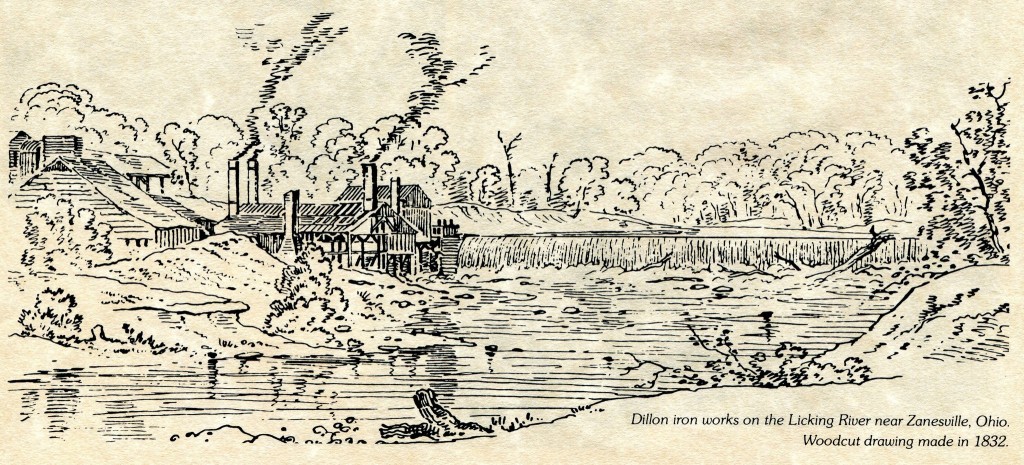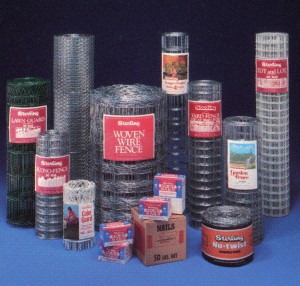Moses Dillon: Early Pioneer in Steelmaking
The history of the Dillon family in the steel making industry is traced back to the Pre-Civil War days in the State of Ohio.
Moses Dillon was an early pioneer in the steelmaking industry. Dillon is shares the distinct honor of being the first steelmaker to build the first iron furnace west of the Allegheny Mountains in Ohio in the early 1800’s.
Dillon built his first steel furnace at Dillon Falls, Ohio, near Zanesville. The mill was operated by Moses Dillon and his son, John. At the time, they produced bar iron and castings.
Following the death of Moses Dillon, the operation was managed by his son, John. John Dillon continued the iron works operation until the vein of ore was exhausted.
John Dillon, 82, died July 17th, 1862 at the home of his daughter, Mrs. Moorehead, in Zanesville, Ohio. It is believed the first Dillon furnace was operated until about 1850. It was in the late 1830’s the Dillon furnace was leased to Henry Blandy and A.F. Blockson.
The Dillon furnace and forge operated for two years without success. An article in the Ohio Courier dated Dec. 24th, 1872, explains why the Dillon Furnace failed.
According to the article, good iron ore in the vicinity of the forge was exhausted and the managers had to resort to other points, often as far as Frazeysburg, for what they had expected to obtain on their own grounds. With the slow transportation of that particular time, the expense of hauling ore that distance was prohibitive.
The newspaper article related, “The iron works fell into ruin and the homes were moved away. Dillon’s Falls became a ghost town for nearly half a century. Then, in 1906, soon after the interurban line was constructed, a cottage colony grew up.”
In the year 1974, there was still a small Dillon Falls community, including a school, small store, and other businesses, and homes on both sides of the Licking River, connected by a highway bridge for local traffic.
There is still a road on the west side of the river from the site where the Dillon iron works once was located and extending south under the present Interstate 70, past the Dillon burying ground joining US Rt. 40.
The first venture by Moses Dillon into the iron business was reported by his son John, in his memoirs.
John explained in his writing, “When in my fourteenth year of age, my father (Moses Dillon) sold his farm in Harford County and moved to Fayette Pennsylvania, near Beaver town, now called Union Town, where he had previously bought one half of a Furnace created by George Meason on Dunbar Run, called Dunbar Furnace.”
Back in Maryland, Moses Dillon once again assumed his place of leadership ith the Society of Friends, which included some missionary trips to the Indians, west of the Alleghenies. In 1803, on a visit on horseback to the Wyandotte Indians in Ohio country, Dillon camped near the falls of the Licking River with his companion, Hugh Judge, a Quaker preacher.
J. F. Everhart in his 1182, History of Muskingum County, Ohio, tells of the visit by Moses Dillon to this country and the affect it had on him.
“Arriving at the falls of the Licking, Dillon was first impressed with the beauty of the landscape, and then with the fact that here was a fine water-power, and conceived the idea of utilizing it for manufacturing purposes.
Before leaving the neighborhood, Dillon discovered iron ore, which increased his determination to make this a business point.
Soon after his return home, he purchased a tract of land including the falls, probably near 3000 acres.
Dillon moved the falls in 1805 and proceeded to erect an iron furnace and foundry and made all kinds of hallow-ware, then in vogue.
First Furnace
Dillon’s furnace was probably the first furnace and foundry erected west of the Allegheny Mountains.
In 1814, Dillon built a gristmill and two sawmills near the falls, one on the east side of the river. These mills and the furnace and foundry, gave employment, sometimes to as many as 150 men.
“In 1806, Dillon opened a store at the Falls of the Licking, with a general assortment of merchandise suited to the wants of the pioneer, and trading with the Indians, many of whom lingered in the region round about, and found it convenient to exchange their skins, furs and other wares and meats, for articles of clothing and ammunition.
The store owned by Dillon was to become an important trading point. The people were allowed to settle on his land nearby, and the village, that grew in this wise – though never regularly laid out, and on one acquired title to the land occupied by then – once numbered 50 families.
Two Sons
Two of Moses Dillon’s sons, John and Isaac, were like himself…enterprising men. He was engaged in business with his sons until the time of his death in 1839.
His son John continued the furnace, foundry, and mills for some years after the elder Dillon’s death.
Interesting Bits
Stories circulated around the area where Moses Dillon’s steel works was located on the Licking River indicate the famed western novelist Zane Gray spent much time there.
While Zane Gray was enrolled at nearby Zanesville High School, he spent more time at Dillon Falls than in classrooms itself. On his tramps and fishing trips to the falls, he became acquainted with “Muddy” Mizer, who lived in a shack on the east side of the river.
Gray later said that the scenery at the falls aroused his interest in the great outdoors. After Gray became famous and wealthy, he paid “Muddy” Mizer’s room rent at a hotel near Altadena, California.
Swim Pool Thomas W. Lewis once wrote that there was a famous swimming pool at the foot of the falls on the west side of the Licking River. But, the flood of 1898 filled it almost full of gravel. Summer residents hoped that the 1913 flood would wash the gravel out, but it did not.
Zane Gray and those who enjoyed the swimming pool in the river would be amazed at the recreational facilities in this particular area today, partly as a result of the 1912 flood.
Dillon Dam
On October 2, 1960, the Dillon Dam on the Licking River was dedicated as a final unit in the Muskingum Valley Flood Control Program of the U.S. Army Corps of Engineers. Located about a mile above the Dillon Falls, the dam backs up the river into a permanent reservoir covering about 1325 acres and extending 10 miles upstream. For storing flood water the pool could be enlarged to 10,285 acres and nearly three times larger than normal.
The Dillon Dam is a rolled, earth-filled structure 118-feet high and 1400 feet long.
First proposed in 1934, construction was delayed by World War II, the Korean War and local objections. Originally estimated at under $7 million, the final cost of the structure was reckoned at $35 million.
Dillon Lake and surrounding area is open to the public for picnicking and water recreation, with the entire area named in honor of the noted pioneer industrialist, Moses Dillon.
Washington Dillon, co-founder of Northwestern Barb Wire Company, at Rock Falls, was the great grandson of Moses Dillon.
Retrieved from the Daily Gazette by Dana Fellows ~ 2011
Transcribed by Rachel Fellows ~ 2011


